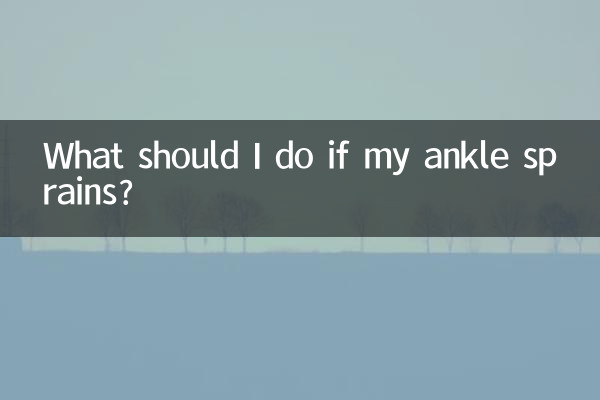Title: What to do if your foot sprains
In daily life, sprains are a common sports injury, especially when exercising, walking, or going up and down stairs. If not handled properly, it may worsen the injury or prolong recovery time. This article will combine the hot topics and hot content on the Internet in the past 10 days to provide you with a detailed guide to the treatment of sprain injuries.
1. Common causes of ankle sprains

Sprained feet are usually caused by sudden twisting or uneven stress on the foot. Here are some common reasons:
| Reason | Description |
|---|---|
| Sports injuries | In sports such as running, basketball, and football, it is easy to cause ankle sprains due to unstable landing. |
| Unsteady walking | It is easy to sprain your feet when wearing high heels or walking on uneven roads. |
| accidental fall | Going up and down stairs or on slippery floors can easily lead to accidental injuries. |
2. Symptom classification of sprained foot injuries
Depending on the severity of the injury, sprain injuries can be divided into three levels:
| Level | Symptoms | recovery time |
|---|---|---|
| Mild | There is slight pain and swelling, and you can walk normally. | 1-3 days |
| Moderate | Obvious pain, swelling, and difficulty walking. | 1-2 weeks |
| Severe | Severe pain, severe swelling, inability to walk, possibly torn ligaments or fractures. | 3-6 weeks or more |
3. Emergency treatment steps for ankle sprains
Here are emergency steps to help relieve pain and speed recovery after a sprained foot injury:
| steps | Operation | Things to note |
|---|---|---|
| 1. Cease activity | Stop walking or exercising immediately to avoid aggravating the injury. | Don't force the walk. |
| 2. Apply ice | Apply an ice pack or cold towel to the injured area for 15-20 minutes each time. | Avoid direct contact with skin to prevent frostbite. |
| 3. Pressure bandaging | Wrap the ankle with an elastic bandage to reduce swelling. | Do not bandage too tightly to avoid affecting blood circulation. |
| 4. Elevate the affected limb | Elevate the injured foot above the level of the heart to promote blood return. | Stay in the elevated position for 15-30 minutes. |
| 5. Medical examination | If the pain is severe or you are unable to walk, seek medical attention promptly. | Rule out the possibility of fractures or torn ligaments. |
4. Things to note during recovery
During the recovery period from a sprained foot injury, the following points require special attention:
| matters | Description |
|---|---|
| Avoid strenuous exercise | During the recovery period, avoid strenuous activities such as running and jumping to prevent secondary injuries. |
| moderate activity | After the pain subsides, gentle ankle movements can be performed to help restore flexibility. |
| diet conditioning | Eat more foods rich in protein and vitamins to promote tissue repair. |
| Wear protective gear | An ankle brace or elastic bandage can be worn to provide extra support during recovery. |
5. Tips to prevent ankle sprains
Prevention is better than cure, here are a few tips to prevent sprained feet:
| Tips | Specific methods |
|---|---|
| Choose the right shoes | Wear supportive sneakers when exercising and avoid high heels or shoes with thin soles. |
| Strengthening ankle exercises | Stability can be enhanced through balance training or ankle strength exercises. |
| Pay attention to road conditions | When walking or running, pay attention to whether the road surface is smooth and avoid stepping on uneven areas. |
| Warm up and stretch | Warm up before exercise and stretch after exercise to reduce the risk of injury. |
Conclusion
Although foot sprain injuries are common, with correct treatment and scientific rehabilitation methods, you can recover quickly and avoid sequelae. If the injury is serious, seek medical attention immediately. I hope this article can help everyone deal with sprain injuries calmly and recover as soon as possible!

check the details

check the details